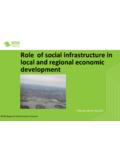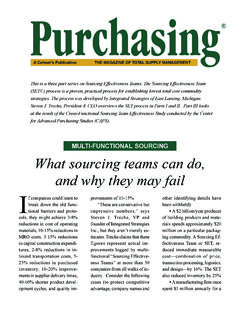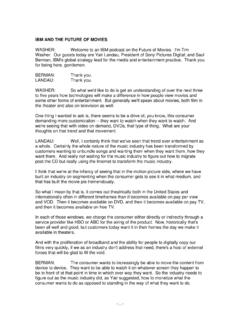Transcription of Revisiting the economics of inclusionary zoning - sgsep.com.au
1 SGS economics and Planning Occasional Paper April 2015 Revisiting the economics of inclusionary zoningby Marcus Spiller, PhDMitra Anderson-OliverSGS Occasional Paper - Revisiting the economics of inclusionary zoningRevisiting the economics of inclusionary zoningMarcus Spiller (PhD) Principal & Partner SGS economics & Planning Pty Ltd Adjunct Professor Global, Urban and Social Studies, RMIT University Mitra Anderson-Oliver (Formerly) Senior Consultant SGS economics & Planning Pty LtdPaper presented to the Australian Housing Researchers Conference Hobart, February 2015 For more information contact Marcus Spillere: (Free to Share) and DisclaimerUsers are welcome to copy and distribute the information contained in this paper provided acknowledgement is given to SGS economics and Planning Pty Ltd as the source.
2 Although every effort has been taken to ensure information contained in this paper is accurate, SGS economics and Planning Pty Ltd accepts no responsibility for inaccuracies. Any action taken by a user or third party in reliance on this information without advice from SGS economics and Planning Pty Ltd is at the sole risk and expense of that economics and Planning Pty LtdACN 007 437 in Canberra, Hobart, Melbourne and Sydney SGS Occasional Paper - Revisiting the economics of inclusionary zoningContentsInclusionary zoning in Australia 1 Resistance to IZ 2 Purpose of this paper 3 The value capture diversion 3 inclusionary zoning and the scope of planning legislation 4 inclusionary zoning and allocative efficiency 5A Brisbane case study 8 Impacts on housing supply and price 10IZ and access to opportunity 12 Avoided social costs 14 Concluding remarks 15 SGS Occasional Paper - Revisiting the economics of inclusionary zoningInclusionary zoning in AustraliaInclusionary zoning (IZ)
3 Generally refers to statutory planning controls requiring development proponents to incorporate certain facilities or features on their site, or pay a cash-in-lieu contribution for this obligation to be discharged off-site. Traditionally, inclusionary provisions were applied to car parking requirements and open space contributions. More recently, requirements to incorporate a certain proportion of affordable housing in a development project, or make a cash contribution for an equivalent quantum and standard of affordable housing to be provided elsewhere in the neighbourhood in question, have been contemplated and, in some cases, implemented, in Australian town planning longest running IZ scheme in Australia applies in Sydney s Ultimo Pyrmont urban redevelopment precinct.
4 This former industrial/port district in the inner city was the subject of a State and Commonwealth Building Better Cities initiative in the early 90s, under which a targeted amount of affordable housing would be maintained in the neighbourhood as it transformed into an otherwise exclusive area for well remunerated knowledge workers . A special purpose, not for dividend company City West Housing Ltd was created by the State Government to own, operate and, where necessary, build the targeted affordable housing. The requisite housing was to be procured via a one off Better Cities capital grant from the Commonwealth, an agreed proportion of the value of State Government land sales in the precinct and the proceeds, both cash and in kind, from the inclusionary zoning scheme applying in the area.
5 In its latest version, the City West IZ scheme requires developers to provide affordable housing at a rate of of the total floor area to be used for residential purposes and of the total floor area that is not intended to be used for residential purposes. In 2009/10, the cash in lieu rates were $ for residential development and $ for non-residential development. City West Housing Ltd reported IZ cash contributions from developers of some $47 million in the 2013/14 financial year (including contributions from an additional nearby urban renewal precinct known as Green Square ).
6 The target set on the launch of the City West Affordable Housing Scheme in 1994 was that some 600 dwellings would be acquired in Ultimo Pyrmont over 30 years as permanently affordable rental stock for very low, low and moderate income households. This target has already been 1 CITY WEST AFFORDABLE HOUSING (ULTIMO PYRMONT) Source: City of Sydney1 1 ( )page 1 SGS Occasional Paper - Revisiting the economics of inclusionary zoningResistance to IZ Notwithstanding this long standing (and seemingly successful) NSW experience with mandatory IZ on private land, there continues to be deep-seated resistance to this planning mechanism in most Australian jurisdictions2.
7 This is particularly so in Victoria, which is a focus of this factors appear to lie behind this resistance. Some critics of IZ see it as a lazy public policy response to the affordable housing crisis, arguing that we should be looking first to address the inefficiencies in the permit approval process, and create greater certainty for developers thereby reducing costs before adding another layer of complexity to the planning system. Others make the point that the provision of non-market or subsidised housing has traditionally been part of the national tax transfer system and should remain that way.
8 Development industry lobbyists, like the Property Council of Australia (PCA) rest their opposition on two points; that IZ is an unfair implicit tax on one group in the housing market to assist another; and IZ can only ever produce a trickle of affordable housing versus the scale of unmet others see IZ as an unwarranted, unjustifiable and objectionable curtailment of private development rights. This is exemplified in a public statement by Councillor Stephen Mayne of the City of Melbourne when deliberating on an officer recommendation for the introduction of IZ in that municipality.
9 At a Council Committee meeting held in December 2014, Councillor Mayne My personal view is that this is a fundamental property rights if you are a private owner of land and you (the Council) come in and mandate that a certain amount of that development cannot be commercial, that is actually quite a moving of the goal posts and quite a change in property rights of individual property owners. 42 A form of inclusionary zoning is applied in SA. All significant projects , including developments on government land, major developments and private developments that are bound by the SA development plan policy for Affordable Housing, must include 15% affordable housing comprising dwellings which are offered for sale at or below a nominated affordable price point (currently $288,000), sold to eligible low to moderate income earners (up to $75,000 for singles, up to $95,000 for couples and families) or affordable rental providers and subject to a legally binding agreement that ensures these requirements are met.
10 (See ) The SA scheme is best seen as a mandatory requirement to diversify price points in major developments. It does not guarantee that these developments will permanently feature a certain proportion of housing accessible to households in the bottom 40% of the income distribution. In this sense, it is not comparable to the Ultimo Pyrmont scheme which is the model of IZ of interest in this Elliot, R. (2007) Myth #9: inclusionary zoning fixes unaffordable housing? Published on-line by the Property Council of Australia 4 , (text in bold added)page 2 SGS Occasional Paper - Revisiting the economics of inclusionary zoningpage 3 Purpose of this paperThis paper revisits the public policy merits of IZ.










